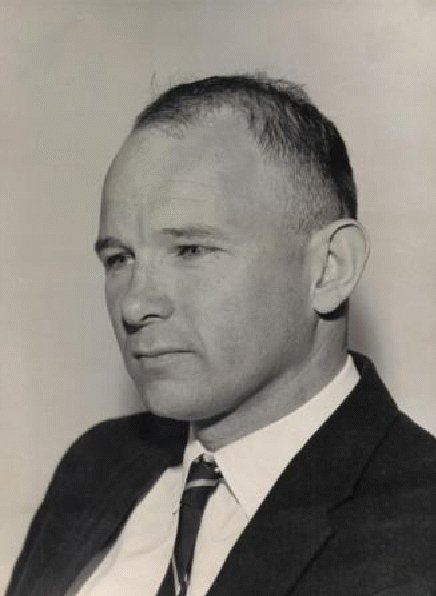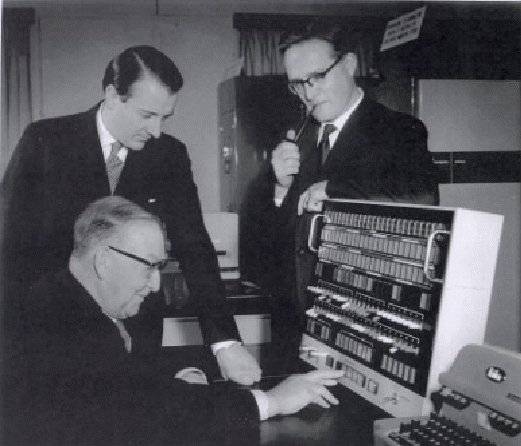

I joined Ferranti after hitchhiking from Sydney to London, having completed my PhD in aeronautical engineering, arriving in January 1961. I planned to work in aeronautics, possibly in the design team of the Concord airliner, but after some interviews I found I'd missed the romantic period of aircraft design (my professor at Sydney University had been in the Spitfire team); also after ten years at university the pay seemed pretty low.
For my PhD I used the SILLIAC computer to solve differential equations on the bending of thin wings so I decided to try for work in a computer company and, walking along Newman Street in London, I passed the offices of Ferranti Ltd. Now I knew a Barry de Ferranti who helped build SILLIAC so I went through the door towards a gentleman behind the desk and told him I was looking for a job. He replied that I should go away and submit an application. As I was walking out, a voice came from the stairs. "Peter Jones: what are you doing here?" It was Barry Ferranti. I told him I was looking for work and he invited me to join him and Bernard Swann, Sales Manager of Ferranti Computer Department, for lunch. His assistant Dr Chris Wilson who managed the London Computer Centres also came along. We had a lengthy discussion on my background and interests then they told me about exciting projects in Ferranti including ATLAS. After lunch I talked with George Felton who was the programming leader, mainly on Orion and ATLAS. At the end of this important day in my life they offered me a job which I accepted and started a few days later. After this I was always called Mr Peter by the gentleman at the door.
It's worth saying something about SILLIAC which was Sydney's version of the University of Illinois Automatic Computer, ILLIAC, developed from the design of John von Neumann and opened for users in September 1952. ILLIAC used the Fred Williams' cathode ray tube memory, developed at Manchester, and David Wheeler from Cambridge contributed to the design. Wheeler with Wilkes and Gill wrote what is regarded as the first book on programming. Harry Messel, professor of Physics, organised the assembly of SILLIAC in Sydney. At the same time from Illinois came an eminent nuclear physicist John Blatt who used SILLIAC and years later advised me to rewrite the operating system for the IBM 360/50. John Bennett, who'd been working with Ferranti and before that as Maurice Wilkes' first research student in 1947 at Cambridge, came to Sydney and joined the SILLIAC team as a numerical analyst in February 1956. The machine was officially opened on September 12th ,1956. I worked with Bennett as a research assistant solving problems on SILLIAC for a year after gaining my PhD.
Though there were various job opportunities in Ferranti, the exciting one I chose was partnering David Howarth on defining and designing the ATLAS Operating System. Bruce Payne was working on this in Manchester and we used to visit him and the whole Atlas team regularly. However we stayed in London for 1961, understanding more of what Ferranti wanted to get out of ATLAS from a marketing viewpoint. Mike Wyld was also a member of the ATLAS Supervisor team. One advantage of working with Ferranti in London was that we got to know senior system designers of other Ferranti machines, such as Conway Berners Lee whose son Tim is recognised as the Internet founder. We also had the opportunity for discussions with leading computer people of the day including Chris Strachey, Stan Gill, Maurice Wilkes and David Wheeler.
Thus we had a backdrop of input as we defined the Atlas Supervisor and scheduler with the Manchester team. Clearly we needed to program and debug directly on the machine and implement a working system so in 1962 we moved to Manchester. The various aspects of ATLAS worked pretty well for us and on time, that is the interrupt system, virtual memory, extra codes, time share, swapping programs plus many other features. We, as the Operating System designers, had the hardware team below us and the compiler group plus application programs above us. The ATLAS team, brilliantly led by Tom Kilburn, included senior designers Dai Edwards, Frank Sumner, Mike Lanigan, Dave Aspinall, Gordon Haley and Yao Chen and the compiler team included Tony Brooker and Derrick Morris - all wonderful to work with. If there were any disagreements we'd adjourn to the College pub and sort things out. My role as developing the scheduler wasn't too difficult, apart from arguments on program priorities.
We worked hard with long hours on the machine - often till the early hours of the morning, going for a hot curry to keep us awake. However, I did take time when directed to go overseas to attend conferences and lecture on ATLAS. So during 1962 and more so in 1963, being 'the footloose Australian' as Tom described me, I stood in for him at conferences and meetings especially when there was a conflict with Manchester United having a home game . There was also the aspect of marketing ATLAS in the US with John Fotheringham and Stan Gill came to Australia with me. Tom had been in Australia for a conference in 1951 put on by the defence department.
One trip I did was to lecture in Moscow invited by A. Smirnov at the Computer Centre, Academy of Sciences, USSR. I got into trouble when I eluded my guards and went by train to St Petersburg for a few days to look at the art galleries.
The exciting thing about these overseas visits was the interest in the Atlas system from computing leaders of the day, such as Fernando Corbato (MIT), John McCarthy & George Forsythe (Stanford), Fred Brooks & Gene Amdahl (IBM), Sid Fernbach (Lawrence Livermore Lab), Grace Hopper (Cobol), John Bachus (Fortran), Ken Iverson (APL) plus many others.
After visiting the US and talking to large computer users, often defence research departments, they concluded that they would like to buy a number of Atlas's but only if they were built and maintained in the USA. When I got back I conveyed this to Ferranti, the University and government department heads but the answer was 'No' to the US request.
The Australian trip in 1963 was focused on bidding for two large government networks, CSIRO and the Bureau of Census and Statistics. Unfortunately we were beaten by Control Data with their 3600 and 3200 lower level machines.
This was the period of large global conferences, the first being IFIP, the International Federation of Information Processing: 1959 Paris, 1962 Munich, 1965 New York, 1968 Edinburgh, 1971 Ljubljana. I went to all these except in 1959. The most important one for me was 1962 in Munich, when a significant Atlas team attended from the University and Ferranti.
Then there were the AFIPS conferences in the US, relevant to ATLAS with their proceedings Volume V20 1961, V22 1962, V23 1963 and V26 1964. Two publications of the IEEE Annals of the History of Computing of interest are Volume 10 #4 and Volume 15 #3 1993 which includes an excellent paper by Simon Lavington on Manchester Computer Architectures, 1948-1975.
Towards the end of 1963 I received a phone call from Bob Price, international manager for Control Data, inviting me to see him in London regarding a job in Minnesota with Seymour Cray on the 6600 super computer. Since my Atlas scheduler project had finished, I went to London to find out more about his offer. We had dinner and he invited me to visit CDC in the US. I thought this would be a fun thing to do so I accepted. I arrived in Minneapolis and met some of their designers, then was taken to Chippewa Falls to see Seymour but he was out fishing would you believe. I wasn't too impressed with this but, like ATLAS, they appeared to have impressive, friendly team members. Before leaving I flew to Los Angeles to meet Bob Barton (designer of the Burroughs B5500) who was going to Australia to head the team installing their newly ordered systems. Returning to Manchester, I talked my decision over with good friends and decided to accept the CDC offering with the condition I could spend 1964 in Australia getting to know their computers by working on their recently purchased systems. It was indeed a sad day leaving Manchester but as a consolation we had a great party at my farm the day I set off. One joyful experience of returning to Australia was finding a wife. We were married on 19th December, 1964 and left for the US two weeks later.

In summary, my ATLAS experience has remained with me all my life and has formed the basis and inspiration for what I tried to do in my computing career. Looking back, I see how the ATLAS machine represented significant advances at all levels of computing - from the hardware design, through the Operating System and then the software compilers followed by applications programs. Equal with the design features was the inspiration of the truly outstanding team led by Tom Kilburn: they became special friends who have made a difference in my life. Two other eminent people had an influence in our design thinking about ATLAS, one was Alan Turing who was at Manchester 1948 to 1954 when he died. The other was Fred Williams who arrived at Manchester with Tom Kilburn in 1947 and set about perfecting a digital store in a cathode ray tube, later being known as Williams tubes, and used in early computers around the world. The Manchester Mark I machine with Williams Tubes executed a program on June 21st 1948 and is generally recognised as the world's first stored-program computer. The story is that Williams never wrote a program and Kilburn wrote just one - the world's first.
I'd like also to pay tribute to Ferranti, a truly great company to work for having vision and giving freedom and support to employees to decide their own way of doing things to achieve important goals.
On the occasion of the 50th anniversary of the opening of ATLAS on 7th December 1962 I will celebrate here in Sydney looking at a photo I've treasured all my life of Sir John Cockcroft pressing a button on the ATLAS console with Sebastian de Ferranti and Prof. Tom Kilburn at his side:

To list just a few examples of ATLAS playing a role in projects I undertook, there was in 1964 the installation of the largest two networks of Control Data 3000 series computers in Australia. Then in 1965 I worked on the operating system for the CDC 6600 for use within defence sites. Then in 1967 I was developing an operating system with two PhD students for the IBM 360/50 and setting up the computer science courses at UNSW (University of New South Wales). Then in 1969 specifying the STAR computer at CDC, containing features of Atlas including virtual memory and in 1973 setting up research programs with the CSIRO while at the ANU (Australian National University). In 1974 I was a founder of Network Systems Corporation (USA) with the Hyperchannel product, enabling computer systems from various manufacturers to network at high speed.
Without my ATLAS experience I doubt any of this would have occurred, so thank you ATLAS.
Peter Jones now lives in Sydney, Australia.